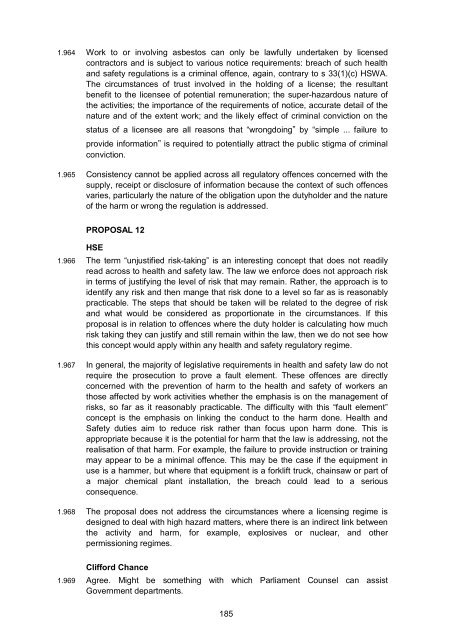Criminal Liability in Regulatory Contexts Responses - Law ...
Criminal Liability in Regulatory Contexts Responses - Law ...
Criminal Liability in Regulatory Contexts Responses - Law ...
Create successful ePaper yourself
Turn your PDF publications into a flip-book with our unique Google optimized e-Paper software.
1.964 Work to or <strong>in</strong>volv<strong>in</strong>g asbestos can only be lawfully undertaken by licensed<br />
contractors and is subject to various notice requirements: breach of such health<br />
and safety regulations is a crim<strong>in</strong>al offence, aga<strong>in</strong>, contrary to s 33(1)(c) HSWA.<br />
The circumstances of trust <strong>in</strong>volved <strong>in</strong> the hold<strong>in</strong>g of a license; the resultant<br />
benefit to the licensee of potential remuneration; the super-hazardous nature of<br />
the activities; the importance of the requirements of notice, accurate detail of the<br />
nature and of the extent work; and the likely effect of crim<strong>in</strong>al conviction on the<br />
status of a licensee are all reasons that “wrongdo<strong>in</strong>g‟ by “simple ... failure to<br />
provide <strong>in</strong>formation‟ is required to potentially attract the public stigma of crim<strong>in</strong>al<br />
conviction.<br />
1.965 Consistency cannot be applied across all regulatory offences concerned with the<br />
supply, receipt or disclosure of <strong>in</strong>formation because the context of such offences<br />
varies, particularly the nature of the obligation upon the dutyholder and the nature<br />
of the harm or wrong the regulation is addressed.<br />
PROPOSAL 12<br />
HSE<br />
1.966 The term “unjustified risk-tak<strong>in</strong>g” is an <strong>in</strong>terest<strong>in</strong>g concept that does not readily<br />
read across to health and safety law. The law we enforce does not approach risk<br />
<strong>in</strong> terms of justify<strong>in</strong>g the level of risk that may rema<strong>in</strong>. Rather, the approach is to<br />
identify any risk and then mange that risk done to a level so far as is reasonably<br />
practicable. The steps that should be taken will be related to the degree of risk<br />
and what would be considered as proportionate <strong>in</strong> the circumstances. If this<br />
proposal is <strong>in</strong> relation to offences where the duty holder is calculat<strong>in</strong>g how much<br />
risk tak<strong>in</strong>g they can justify and still rema<strong>in</strong> with<strong>in</strong> the law, then we do not see how<br />
this concept would apply with<strong>in</strong> any health and safety regulatory regime.<br />
1.967 In general, the majority of legislative requirements <strong>in</strong> health and safety law do not<br />
require the prosecution to prove a fault element. These offences are directly<br />
concerned with the prevention of harm to the health and safety of workers an<br />
those affected by work activities whether the emphasis is on the management of<br />
risks, so far as it reasonably practicable. The difficulty with this “fault element”<br />
concept is the emphasis on l<strong>in</strong>k<strong>in</strong>g the conduct to the harm done. Health and<br />
Safety duties aim to reduce risk rather than focus upon harm done. This is<br />
appropriate because it is the potential for harm that the law is address<strong>in</strong>g, not the<br />
realisation of that harm. For example, the failure to provide <strong>in</strong>struction or tra<strong>in</strong><strong>in</strong>g<br />
may appear to be a m<strong>in</strong>imal offence. This may be the case if the equipment <strong>in</strong><br />
use is a hammer, but where that equipment is a forklift truck, cha<strong>in</strong>saw or part of<br />
a major chemical plant <strong>in</strong>stallation, the breach could lead to a serious<br />
consequence.<br />
1.968 The proposal does not address the circumstances where a licens<strong>in</strong>g regime is<br />
designed to deal with high hazard matters, where there is an <strong>in</strong>direct l<strong>in</strong>k between<br />
the activity and harm, for example, explosives or nuclear, and other<br />
permission<strong>in</strong>g regimes.<br />
Clifford Chance<br />
1.969 Agree. Might be someth<strong>in</strong>g with which Parliament Counsel can assist<br />
Government departments.<br />
185
















